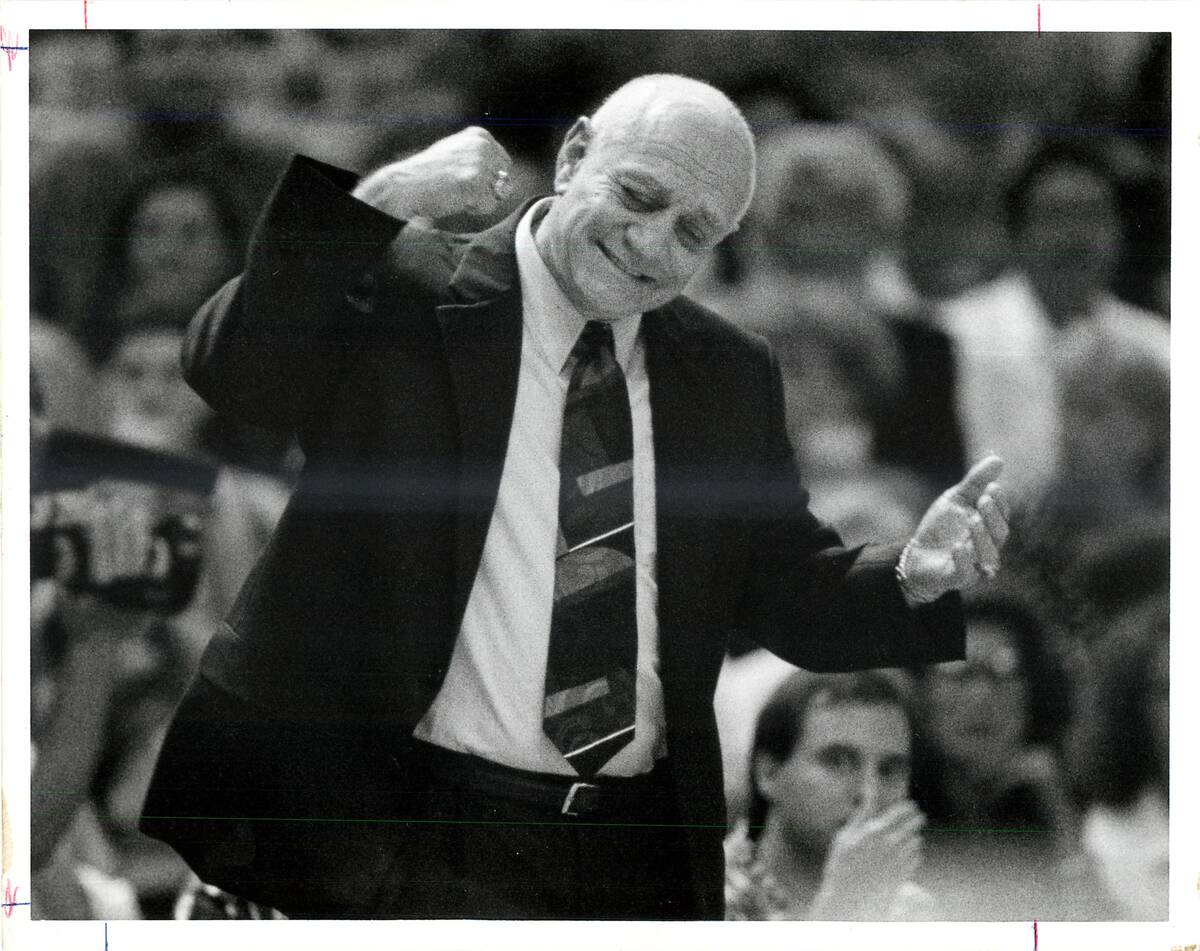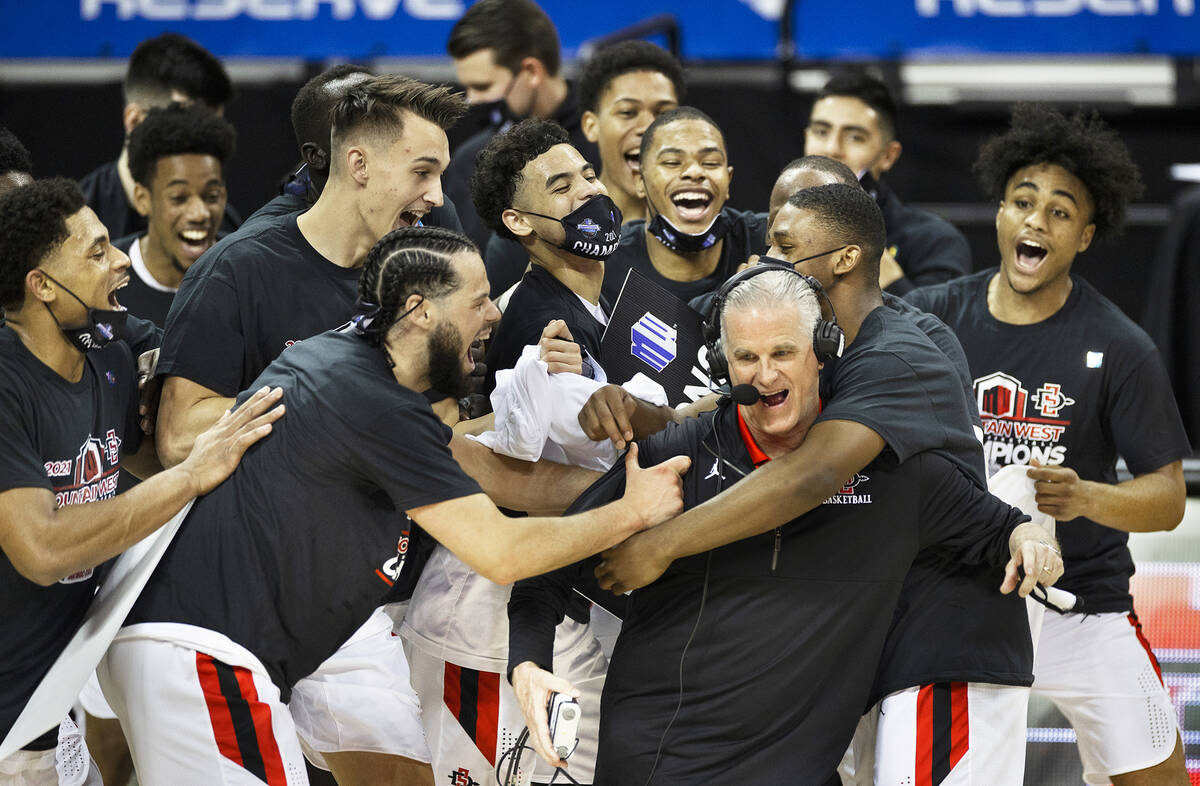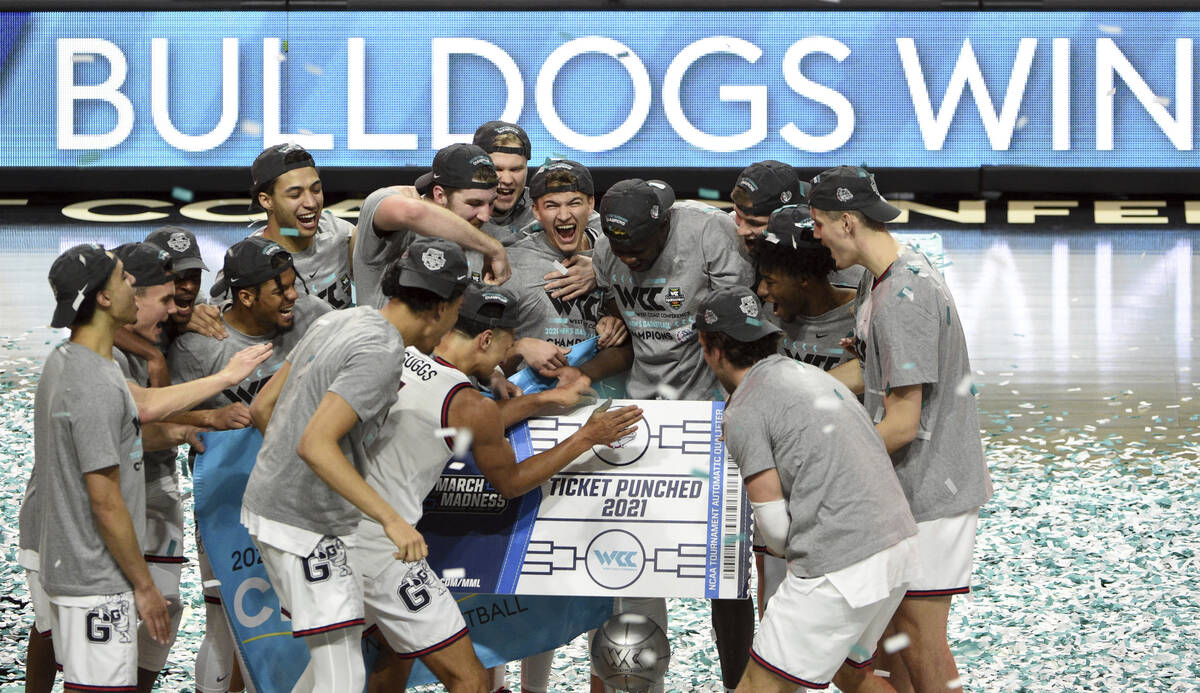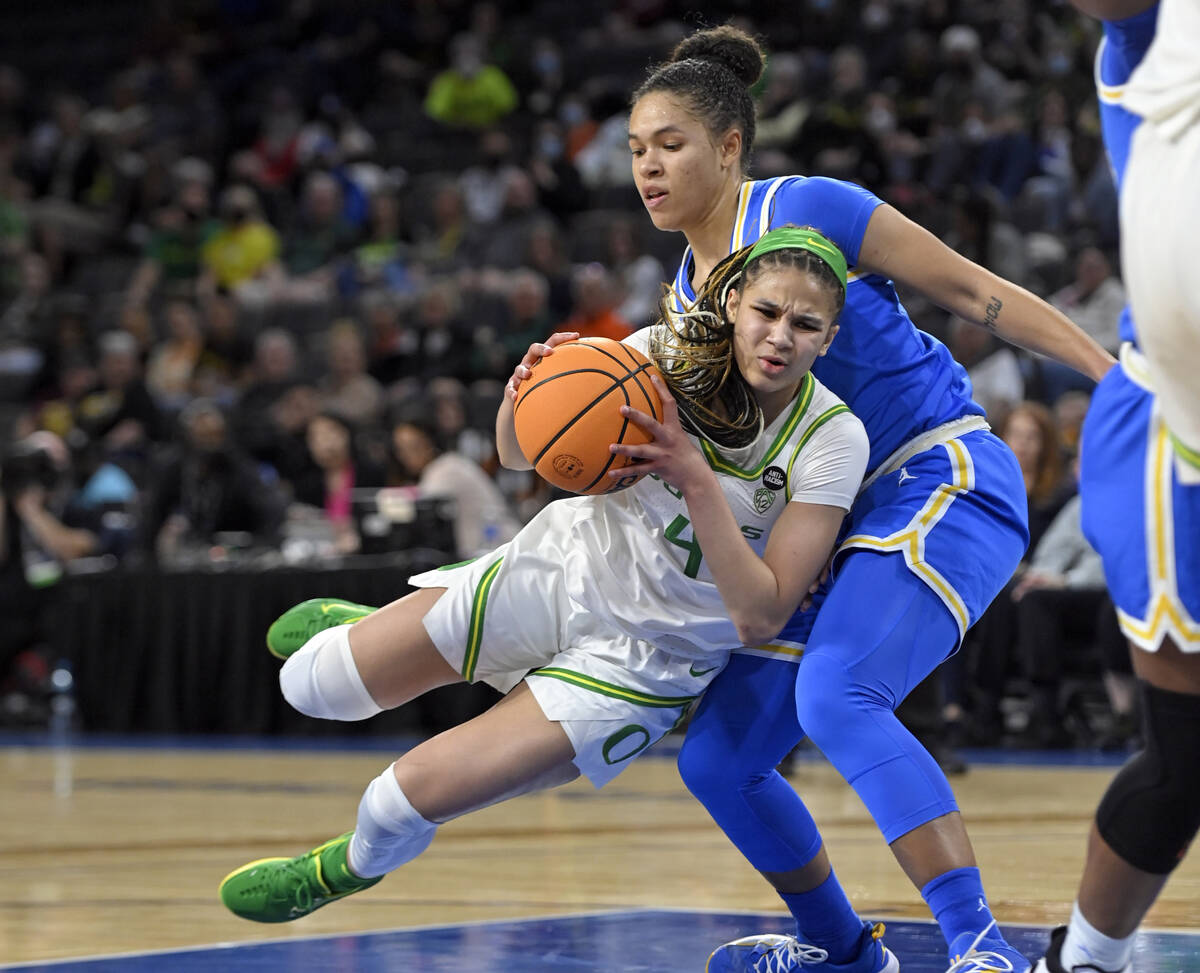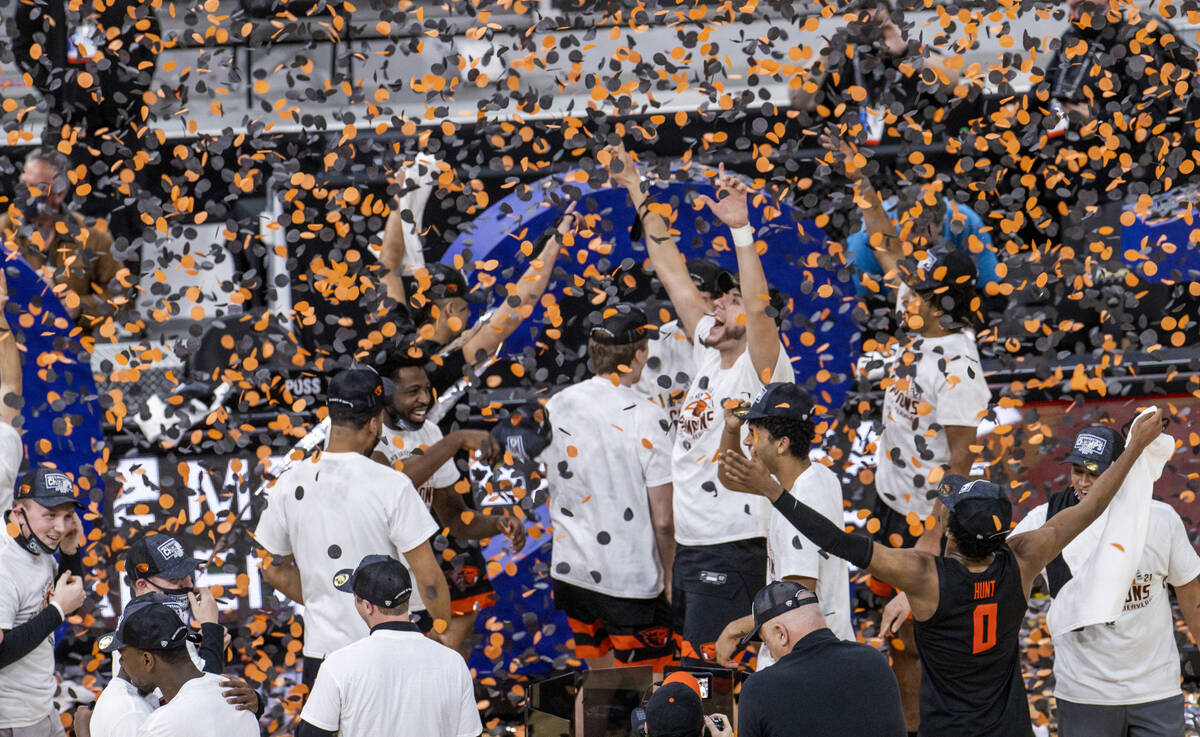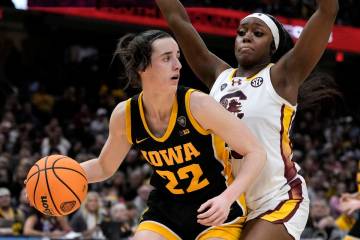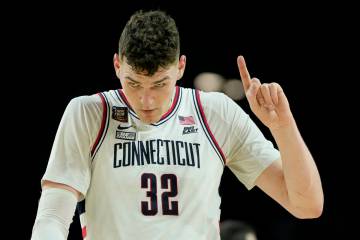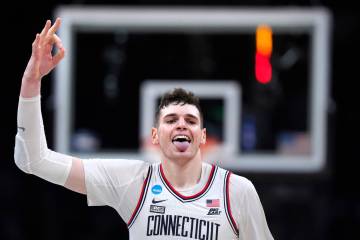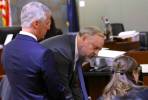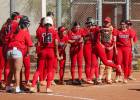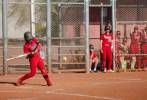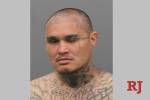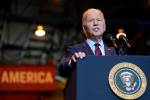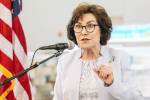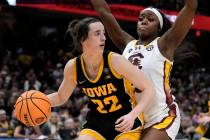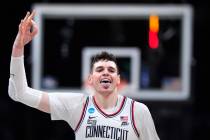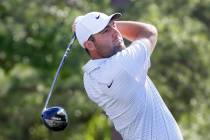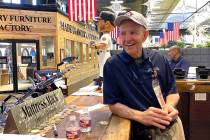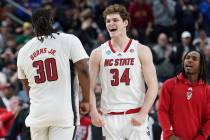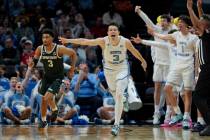How 1 college basketball tourney became 10 in Las Vegas
Tucker DiEdwardo identified the risk and the reward that would accompany his revolutionary proposition to the 16 athletic directors who once ruled the Western Athletic Conference.
What he wouldn’t identify during a conversation last week were the names of those who panned the $1 million proposal that lured their conference basketball tournaments to Las Vegas.
Or the name of the San Diego hotel inside which he’d lightheartedly present the proposal to the tune of Timbuk 3’s “The Future’s So Bright, I Gotta Wear Shades.”
Doesn’t remember after 27 years.
“Nobody … would guarantee the kind of money we guaranteed at that time,” said DiEdwardo, once the NCAA’s assistant director of championships and formerly the president of Las Vegas Events. “They didn’t have to (accept) it, but I was happy that they did.”
The 16-team WAC men’s basketball tournament debuted at the Thomas & Mack Center 25 years ago this week. Now five conferences and 10 men’s and women’s conference tournaments call Las Vegas their home in early March.
Their presence, if only for a week or so, bolsters a robust sporting landscape that also includes the Knights, Aces, Raiders, boxing and mixed martial arts.
But college basketball maintains the foothold here that preceded — and paved the way for — the arrival of its professional sporting counterparts. It remains strong, independent of the collegiate program that harnessed and powered the city’s appetite for hoops: UNLV.
Important college basketball games and tournaments still pack arenas and hotels, and have long showcased the viability of Las Vegas as a burgeoning basketball mecca.
“It all stems from basketball and college basketball,” said Marc Ratner, now the UFC’s vice president of regulatory affairs, formerly the executive director of the Nevada State Athletic Commission, and a local resident for nearly 70 years.
UNLV planted seed
The tournaments and events that populate Las Vegas with basketball fans were once deterred by the NCAA, an ardent opponent of the gaming that drives the city and its economy. Even locals were barred from legally betting on UNLV or UNR and its teams until 2001. But such viewpoints and restrictions couldn’t upend the Rebels and their reign.
The hiring of Jerry Tarkanian in 1973 and the subsequent success would transform a tepid fan base into a rabid one that packed the Las Vegas Convention Center for home games and necessitated the construction of the Thomas & Mack Center, then a world-class arena suitable for one of the best programs in college basketball.
It opened in 1983 and altered the local landscape with its 18,500 seats and the seemingly endless possibilities they presented. Even the NBA’s Utah Jazz were a tenant for 11 games during the 1983-84 season as they considered relocation amid their struggles in Salt Lake City.
Basketball in Las Vegas was booming, with a rich prep and club basketball scene supporting UNLV’s rise to national prominence.
“The program just kept getting better,” said Pat Christenson, then the arena’s assistant director and now the president of Las Vegas Events. “Thomas & Mack and the Rebels were it in this town,” and beyond.
DiEdwardo fondly remembered the way UNLV’s fans flocked in 1991 to the Hoosier Dome for the Final Four to cap an NCAA Tournament that he attended as the Midwest Collegiate Conference’s commissioner. The market intrigued the former athletic administrator, who bailed on a bar he’d opened in Maine and moved to Las Vegas in 1994 at the recommendation of former Rebels men’s soccer coach and longtime friend Barry Barto.
DiEdwardo was hired that year by Las Vegas Events and tasked with bringing different events to a city that in 1994 and 1995 played host to the Big West and its conference tournament.
UNLV was a member school, but conference realignment would dissolve that iteration of the Big West and move the Rebels into the WAC, a burgeoning league that would field 16 programs for the 1996-97 season.
Planning for its first 16-team conference tournament began at the WAC’s meeting in the spring of 1995. DiEdwardo maintained a friendship with former conference commissioner Karl Benson, who welcomed his pitch alongside the conference’s athletic directors on that afternoon in a San Diego hotel.
DiEdwardo, drawing on the Rebels and their success, was confident that he could pack the Thomas & Mack Center. But his pitch to the WAC also included a $1 million offer for the league’s football championship at Sam Boyd Stadium, creating some internal trepidation.
“That was going to be a stretch because Sam Boyd only sat 30,000 people, and I probably needed 35,000 to break even,” DiEdwardo said. “But I was pretty confident with what we could do,” and for good reason.
The WAC accepted the offer and a marketing team spurred sales of more than 40,000 tickets for the inaugural football championship game between Brigham Young and Wyoming. Average crowds for the basketball tournament at Thomas & Mack Center exceeded 15,000 from 1997 through 1999, and sellouts weren’t uncommon.
UNLV departed the WAC for the Mountain West before the 1999-2000 season. The WAC moved its tournament to various cities within the league before returning in 2011 to Las Vegas. But a precedent had been set. Thomas & Mack Center hosted the Mountain West tournament from 2000 to 2003 before returning indefinitely in 2007.
“It was a good model moving forward for how we could do events,” DiEdwardo said. “Particularly collegiate athletic events.”
Valley High to the rescue
The annual Puerto Rico Shootout was flush with talented programs and players. The 1999 field featured eventual national champion Michigan State, Virginia, South Carolina and Texas.
Problem was, it didn’t generate the kind of revenue promoter Chris Spencer had hoped it would, prompting him to consider other locations for the annual Thanksgiving event.
Like, say, Las Vegas.
Spencer sought to promote events in cities that doubled as destinations with adequate hotel space and entertainment options. Plus, Las Vegas had just hosted the WAC tournament. He’d booked a holiday tournament — the Las Vegas Invitational — inside the ballroom at the Paris, garnering the NCAA’s approval in the process.
But politicians like John McCain and Lindsey Graham were outraged at the mere idea of college basketball inside a casino. They applied public pressure on the NCAA and coaches of the programs committed to play in Spencer’s pilot invitational in Las Vegas.
“I’m stunned. This is unbelievably stupid,” Rep. Lindsey Graham (R-S.C.) told the Washington Post in July of 2001. “If the NCAA has the power to stop this and they chose not to, it’s a mistake. If it’s beyond their control, I’m very disappointed in the schools because the fight for the integrity of the game will be hampered by this very mixed message.”
Realizing he’d have to pivot, Spencer, based then in Cincinnati, flew to Las Vegas to search for an alternative venue. UNLV, Spencer said, would not let him use its facilities for his event. But Ron Montoya, a former point guard at Saint Mary’s turned Valley High School principal, would.
Spencer approached Montoya about using Valley’s gym. Montoya at the time was seeking money to fund school lunches for needy kids who couldn’t afford them. The two negotiated booking and venue fees, bringing the first Las Vegas Invitational to Valley that winter — and feeding students along the way.
The field at Valley High included Cincinnati, Purdue and Texas A&M, and capacity crowds of 2,000 filled the school’s tiny gymnasium during the championship gameto foster a personal setting that bigger venues cannot replicate.
Bigger, better
Spencer’s events remained at Valley for the ensuing four years, even though capacity crowds would have violated the building and county fire codes. With that in mind, he began exploring venues that could support bigger fan bases. Namely the Las Vegas Convention Center.
The venue had housed basketball before, and Spencer was willing to spend $100,000 to construct the requisite seating. But a dormant arena a few miles away already had the necessary seating — along with a general manager willing to disrupt the status quo.
Former UNLV quarterback Steve Stallworth.
Orleans Hotel & Casino’s arena seats 9,500 and was built separately from the casino that housed its sportsbook. Stallworth was eagerly seeking events and tenants. He believed college basketball could function at Orleans Arena because its entrances are separate from the hotel’s.
UNLV seemed to disagree, bypassing an opportunity to play at the Orleans in 2006 during the National Finals Rodeo at the Thomas & Mack to play a “home” game Dec. 2 against Northern Arizona in St. George, Utah.
But Spencer didn’t disagree. And neither did representatives from Florida and Kansas, the top programs he’d recruited to play in the 2006 Las Vegas Invitational. So Stallworth contacted administrators from both programs, learning Florida would commit to Orleans Arena if Kansas did.
Stallworth welcomed former Kansas official Larry Keating to Las Vegas, picking him up from the airport and driving straight to Orleans Arena to tour the facility.
“What’s wrong with this?” Keating asked rhetorically, his question an endorsement of the facility.
“Larry, I’ve been trying to tell everybody that,” Stallworth exclaimed.
A deal was finalized, and on Nov. 25, 2006, the two juggernauts played before a sellout crowd comprised mostly of rowdy Jayhwaks fans and a national audience on ABC. Games in the invitational were the first played on a gaming property, though student-athletes were schooled beforehand by university staffers about the perceived dangers of sports betting.
Bob Scucci, Boyd Gaming’s vice president of race and sports operations, would host training sessions with compliance officers from schools playing at the property.
“Simple things. Don’t talk to strangers. ‘How’s the ankle feeling today?’ That kind of thing,” Scucci said. “Just be wary, because you don’t want the student-athletes to be expolited in any way.”
“We worked very well together during those times when Nevada was the only place to have sports betting. Those education processes are still taking place, but now on a national scale. Which is great.”
Championship feel
Gonzaga was getting good. Too good for the West Coast Conference’s traditional tournament format. The league had utilized the campuses of its member schools for its annual basketball tournament. But the Bulldogs were blossoming into one of the nation’s elite programs, and the WCC’s venues were too small.
Orleans Arena, though, was perfect in size and location, per former associate commissioner Gloria Nevarez, who was tasked with canvassing the Western region.
“We had some trepidation about the gambling and some of the reputation of Las Vegas. Especially for a mission-based league like ourselves,” said Nevarez, now the league’s commissioner after stints at Oklahoma and in the Pac-12. “But the Orleans was just amazing. It just really fit.”
The WCC tournaments debuted before a sellout crowd in 2009 at the Orleans, where they’ve remained ever since. The WAC followed suit in 2011, and the Pac-12 debuted its annual men’s tournament at MGM Grand Garden in 2013 before moving to T-Mobile Arena in 2019. The women followed in 2019 and play now at Michelob Ultra Arena.
The Big West returned last year for the first time since 2000, giving five leagues a March presence in Las Vegas.
“What we want to do when we run a conference tournament is give (the players) an experience that is differentiated from the regular season. A championship experience,” said Pac-12 deputy commissioner Jamie Zaninovich, the WCC’s commissioner from 2008 to 2014.
“All the things that Las Vegas offers, the quality of venue, the fans that are attracted to it, the quality of hotel properties that the kids can stay in. The level of customer service. It’s unlike anything else,” he added. “You just notice it the moment you hit the ground. … It’s tangible. The fans feel it. The student-athletes feel it The coaches feel it.”
They’ll feel it on a grander scale in 2023 when the NCAA brings the West Regional of its annual men’s basketball tournament to T-Mobile Arena. So, too, do the Knights, Aces and Raiders, who have rooted their franchises in Las Vegas by following the precedent that college basketball helped set.
Stallworth said the “big-time” college basketball games proved to professional leagues that fan bases will travel to support their respective teams.
“If we had to rely on the locals to support all these tournaments, it would never happen,” said Stallworth, who books basketball games now as South Point Arena’s general manager. “But it showed these leagues that fans will come to Vegas. And it’s proven, right? Look at the Raiders games. …
”Once we get those events, we’ve got to keep them. We’ve got to treat them right. Do all the right things. But Vegas gets our foot in the door.”
Contact Sam Gordon at sgordon@reviewjournal.com. Follow @BySamGordon on Twitter.
Growth spurt
Conference tournaments' arrival in Las Vegas
1994: Big West men and women at Thomas & Mack Center
1998: WAC men and women at Thomas & Mack Center
2000: Mountain West men and women at Thomas & Mack Center
2009: WCC men and women at Orleans Arena;
2013: Pac-12 men at MGM Grand Garden
2019: Pac-12 women at MGM Grand Garden




